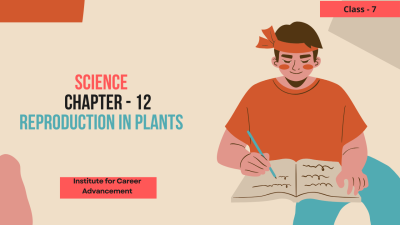Course description
In Class 7 biology, the topic of "Reproduction in Plants" provides a foundational understanding of how plants reproduce, ensuring their survival and propagation. Here’s a comprehensive overview of what is typically covered:
1. Types of Reproduction in Plants:
Sexual Reproduction:
Structure of Flowers: Parts of a flower (sepals, petals, stamens, pistil).
Pollination: Transfer of pollen from anther to stigma (self-pollination vs. cross-pollination).
Fertilization: Fusion of pollen (male gamete) with ovule (female gamete) to form seeds.
Seed Formation: Development of seeds containing embryo and stored food.
Asexual Reproduction:
Vegetative Propagation: Reproduction without seeds.
Types: Runners, tubers, bulbs, rhizomes, and cuttings.
Advantages: Clonal propagation, rapid multiplication, maintaining desirable traits.
2. Life Cycle of Plants:
Alternation of Generations:
Spore Formation: Production of spores (haploid) through meiosis in sporophyte.
Gametophyte Formation: Development of gametophyte (haploid) from spores.
Gamete Production: Formation of male and female gametes.
Fertilization and Seed Development: Fusion of gametes leading to zygote formation and seed development.
3. Significance and Adaptations:
Ecological Importance: Role of plant reproduction in ecosystem stability and biodiversity.
Adaptations: Structural and physiological adaptations of flowers for efficient pollination.
Seed Dispersal: Mechanisms for dispersing seeds (wind, water, animals) and ensuring plant spread.
4. Practical Applications and Examples:
Cultivation Practices: Understanding plant reproductive strategies for crop cultivation.
Conservation Efforts: Importance of preserving plant diversity through seed banks and conservation practices.
Human Impact: Impact of human activities on plant reproduction and biodiversity.
5. Vocabulary and Concepts:
Terminology: Pollination, fertilization, stamen, pistil, ovule, stigma, anther, seed dispersal, germination.
Diagrams: Illustrations of flower structure, pollen transfer, and seed development processes.
ক্লাস 7 জীববিজ্ঞানে, "উদ্ভিদের মধ্যে পুনরুত্পাদন" বিষয়বস্তু উদ্ভিদ কীভাবে পুনরুত্পাদন করে, তাদের বেঁচে থাকা এবং বংশবিস্তার নিশ্চিত করে তার একটি মৌলিক ধারণা প্রদান করে। এখানে সাধারণত কি কভার করা হয় তার একটি বিস্তৃত ওভারভিউ:
1. উদ্ভিদের প্রজননের প্রকার:
যৌন প্রজনন:
ফুলের গঠন: ফুলের অংশ (সেপাল, পাপড়ি, পুংকেশর, পিস্টিল)।
পরাগায়ন: পরাগ থেকে কলঙ্কে স্থানান্তর (স্ব-পরাগায়ন বনাম ক্রস-পরাগায়ন)।
নিষিক্তকরণ: বীজ গঠনের জন্য ডিম্বাণু (মহিলা গ্যামেট) এর সাথে পরাগ (পুরুষ গ্যামেট) এর সংমিশ্রণ।
বীজ গঠন: ভ্রূণ এবং সঞ্চিত খাদ্যযুক্ত বীজের বিকাশ।
অযৌন প্রজনন:
উদ্ভিজ্জ বংশবিস্তার: বীজ ছাড়াই প্রজনন।
প্রকার: রানার, কন্দ, বাল্ব, রাইজোম এবং কাটিং।
উপকারিতা: ক্লোনাল প্রচার, দ্রুত সংখ্যাবৃদ্ধি, পছন্দসই বৈশিষ্ট্য বজায় রাখা।
2. উদ্ভিদের জীবনচক্র:
প্রজন্মের পরিবর্তন:
স্পোর গঠন: স্পোরফাইটে মিয়োসিসের মাধ্যমে স্পোর (হ্যাপ্লয়েড) উৎপাদন।
গেমটোফাইট গঠন: স্পোর থেকে গেমটোফাইট (হ্যাপ্লয়েড) এর বিকাশ।
গেমেট উত্পাদন: পুরুষ এবং মহিলা গেমেটের গঠন।
নিষিক্তকরণ এবং বীজ বিকাশ: গ্যামেটের সংমিশ্রণ যা জাইগোট গঠন এবং বীজ বিকাশের দিকে পরিচালিত করে।
3. তাৎপর্য এবং অভিযোজন:
পরিবেশগত গুরুত্ব: বাস্তুতন্ত্রের স্থিতিশীলতা এবং জীববৈচিত্র্যে উদ্ভিদের প্রজননের ভূমিকা।
অভিযোজন: দক্ষ পরাগায়নের জন্য ফুলের কাঠামোগত এবং শারীরবৃত্তীয় অভিযোজন।
বীজ বিচ্ছুরণ: বীজ (বাতাস, জল, প্রাণী) ছড়িয়ে দেওয়ার প্রক্রিয়া এবং উদ্ভিদের বিস্তার নিশ্চিত করা।
4. ব্যবহারিক প্রয়োগ এবং উদাহরণ:
চাষ পদ্ধতি: ফসল চাষের জন্য উদ্ভিদের প্রজনন কৌশল বোঝা।
সংরক্ষণ প্রচেষ্টা: বীজ ব্যাংক এবং সংরক্ষণ অনুশীলনের মাধ্যমে উদ্ভিদ বৈচিত্র্য সংরক্ষণের গুরুত্ব।
মানবিক প্রভাব: উদ্ভিদের প্রজনন এবং জীববৈচিত্র্যের উপর মানুষের কার্যকলাপের প্রভাব।
5. শব্দভান্ডার এবং ধারণা:
পরিভাষা: পরাগায়ন, নিষিক্তকরণ, পুংকেশর, পিস্তিল, ডিম্বাণু, কলঙ্ক, পীঠ, বীজ বিচ্ছুরণ, অঙ্কুরোদগম।
ডায়াগ্রাম: ফুলের গঠন, পরাগ স্থানান্তর এবং বীজ বিকাশ প্রক্রিয়ার চিত্র।



















